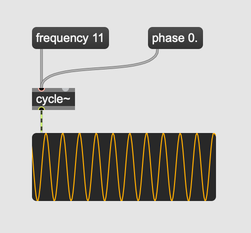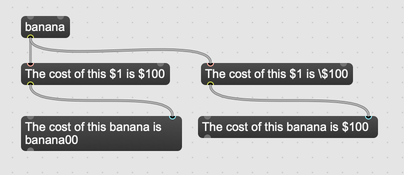Messages
Messages Overview
Max objects communicate with each other by sending each other Messages. A message consists of one or more Atoms, where each atom can be a bang, a symbol, an int, or a float.
- bang: empty atom, a bang means "do it"
- symbol: one or more alphanumeric characters
- int: a whole number
- float: a number with a decimal part
If a message contains multiple atoms, it's referred to as a list. The atoms in a list are separated by spaces. If a symbol atom must contain spaces, the whole symbol should be escaped with double-quotes. When an object receives a message, what the object does depends on the first element of the message. For example, the cycle~ oscillator object can respond to messages by changing its frequency or phase.
This first element of a Max message, which determines how an object will interpret the message, doesn't have a special name in Max, but you may sometimes hear it called a selector, since it functions in a similar way to a selector in programming languages like Smalltalk or Objective-C.

Interpreting Messages
The way an object responds to a message depends on two things: the contents of the message, and the inlet that receives the message. Generally, every inlet is bound to a specific function, but you can override that function depending on how you format your message. For example, the second inlet of the cycle~ object sets the phase of the oscillator, and when cycle~ receives a float or int value in its second inlet, it will interpret that number as changing the phase of the oscillator. However, if you really want to, you can send the cycle~ a message like phase 0.5 to any inlet, and the cycle~ object will always update its phase. This might be a confusing way to design your patcher, but it's allowed.
Because of this flexibility, an object could respond to multiple messages in the same way. When a cycle~ object gets a float in its first inlet, it will change its frequency. The same is true if it gets an int message, or the message float 440. Also, you could send the message frequency 440 to any inlet, and the result would be the same.

Message Box
A Message Box is a special kind of UI object that contains a single message. When you click on a message box or send it a bang, the message box will respond by sending out its contents as a message. Message boxes are extremely flexible and fulfill all kinds of functions in a Max patcher. You can use a group of message boxes to store values, to format other messages, or to view the messages that are passing between other objects.

Viewing Messages
The easiest way to view a message is to connect a patch cord to the right inlet of a message box. Lists of any kind can easily be viewed this way.

One thing to keep in mind when using a message box this way is that the message box will only display the last message that it received. Sometimes it's not clear that a message box has actually received multiple messages, since only the last message received will be displayed. When you want to view all of the messages that have been sent along a given patch cord, you can use the print object to log messages to the Max console.

Finally, you can set breakpoints and watchpoints on your patch cords, for even more precise control over how messages move through your patcher. See Debugging and Probing for more details.
Dollar sign replacement
If a message box contains the special $ character, followed immediately by one of the digits 1-9, that message box will re-format any messages that come through it. The characters $1 will be replaced by the first element of the incoming message, the characters $2 will be replaced by the second element, and so on. Characters like $1 and $2 do not need to appear in order, and they can appear any number of times. So the message $2 $1 will reverse the first two element of an incoming message, and the message $1 $1 $1 will repeat the first element three times. If you want a symbol to begin with $1 and for those characters not to be replaced, add the backslash \ character before the $ to escape it.

Dollar-sign replacement will only work if the characters like $1 appear at the beginning of a word. So sending a message like 34 to $1-bis would result in 34-bis, but sending the same message to bis-$1 won't cause any replacement to happen.
Commas
Commas in a message box will cause a single message box to send multiple messages. If you click on a message box containing the text 1, 2, 3, that message box will send the message 1, followed by the message 2, followed by the message 3. If you're new to Max, probably the first place you'll see this is in conjunction with the line~ object, where a single-element message sets the value of line~ immediately, and the following list message gives line~ an envelope to follow.

Semicolon prefix
Finally, the semicolon character ; has a special meaning whenever it appears at the beginning of a message. When you trigger a message box beginning with a semicolon, instead of sending that message to its first outlet, the message box will send a message to the named destination in the global namespace.
For example, a message like ; max clearmaxwindow will send the message clearmaxwindow to the global object named max. In this case, this message will tell Max to clear the Max console. Messages like this are commonly used to script and control the Max application itself. This is useful for controlling Max with messages, for controlling Jitter with messages, and for controlling DSP with messages.
Because send and receive objects are also in the global namespace, you can send messages to these objects as well using messages with the semicolon character. This is not a common pattern, but you're welcome to do it anyway.

Escaping characters
You can use the backslash character to escape a single character anywhere in a message box. For example, you can use a backslash before the $ character if you want to make sure that the $ is not interpreted as a placeholder for dollar-sign replacement.

To escape multiple characters, or a whole sequence of characters, you can enclose everything you want to escape in double quotes. Note that single quotes will not work, so the message box containing 'hi there' contains two symbols: 'hi and there'. Double quotes are often useful if you want a block of text containing spaces to be interpreted as a single symbol.
